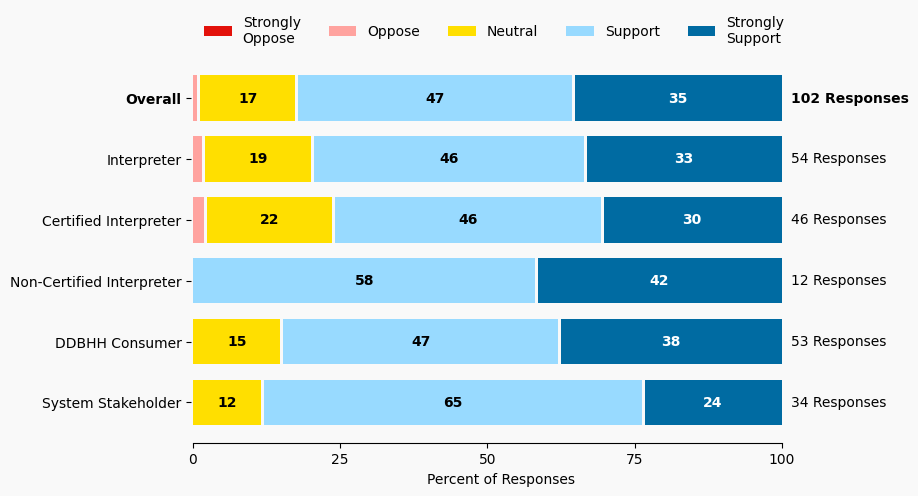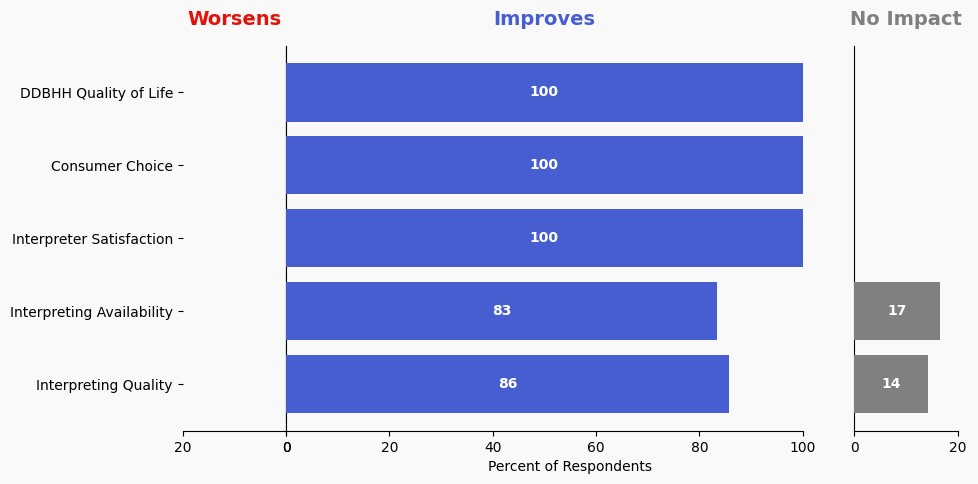109 Develop Models of Typical Interpreting Career Paths
Issue: Prospective interpreters or interpreting students often do not have a clear idea on what it is like to become a skilled interpreter or what an interpreting career looks like.
Proposed Solution: A working group, likely through MRID, develops multiple “typical trajectories” of an interpreting career, including current market trends of compensation. As many prospective interpreters are not clear on what a typical interpreting career may look like, it’s difficult to have realistic expectations regarding the length of time to become a proficient interpreter, or to become an interpreter that specializes in different areas. Further, the ficial aspect of interpreting is a challenge to understand without understanding the typical career path of an interpreter.
Expected outcome: With a greater understanding of potential career paths, it’s possible that more people would want to become an interpreter. Mid-career interpreters may also appreciate more clarity about different specialty options to 1) diversity into specialty areas and/or 2) reduce burnout and increase compensation in some settings.
Who is impacted: Students, new interpreters, experienced interpreters
Timeline: 6 months

Summary of Support Image Description
The stacked bar charts show how respondents rated their level of support and the total number of responses. The percentage for the five support levels is shown from left to right: Strongly Oppose (Dark Red), Oppose (Light Red), Neutral (Yellow), Support (Light Blue), and Strongly Support (Dark Blue).
Respondents may identify with multiple subgroups. The overall level of support is:
Overall
Strongly Oppose: 0%
Oppose: 1%
Neutral: 17%
Support: 47%
Strongly Support: 35%
Click to see the detailed image description for each subgroup.
Interpreter
Strongly Oppose: 0%
Oppose: 2%
Neutral: 19%
Support: 46%
Strongly Support: 33%
Certified Interpreter
Strongly Oppose: 0%
Oppose: 2%
Neutral: 22%
Support: 46%
Strongly Support: 30%
DDBHH Consumer
Strongly Oppose: 0%
Oppose: 0%
Neutral: 15%
Support: 47%
Strongly Support: 38%
Non-Certified Interpreter
Strongly Oppose: 0%
Oppose: 0%
Neutral: 0%
Support: 57%
Strongly Support: 42%
System Stakeholder
Strongly Oppose: 0%
Oppose: 0%
Neutral: 12%
Support: 65%
Strongly Support: 24%
Overview of Respondents Opting for In-Depth Solution Analysis
After indicating their support level, 3% of the 102 respondents opted in to further assess whether the solution would worsen or improve on five metrics. Of the opt-in reviewers (4 respondents), 100% supported the solution, 0% were neutral on the solution, and 0% opposed the solution.
The remaining 98 respondents did not opt in to further assess the solution. Of these people, 81% support the solution, 17% were neutral on the solution, and 1% opposed the solution.
Reviewer Evaluation of Solution Effectiveness

Solution Effectiveness Image Description
The stacked bar charts show how respondents assessed the effectiveness of this solution based on five metrics. For each metric, the percentage of respondents is shown from left to right: Worsens (Red), Improves (Blue), No Impact (Gray).
DDBHH Quality of Life
Makes It Worse 0%
Makes It Better 100%
No Impact 0%
Interpreter Satisfaction
Makes It Worse 0%
Makes It Better 100%
No Impact 0%
Consumer Choice
Makes It Worse 0%
Makes It Better 100%
No Impact 0%
Interpreting Availability
Makes It Worse 0%
Makes It Better 83%
No Impact 16%
Interpreting Quality
Makes It Worse 0%
Makes It Better 85%
No Impact 14%
Reviewer Feedback and Insights
Interpreter
Comments from Interpreters express enthusiasm for the idea and willingness to participate in videos showcasing various specialties, pay scales, and practical career trajectories. One comment raises concerns on the potential burden on non-profit organizations and a need for collaboration with others to provide adequate support.
Deaf, DeafBlind, Hard of Hearing
No comments were submitted.
System Stakeholder
Comments from System stakeholders indicate the need for salary information by interpreting specialty, years of experience, and additional information regarding benefits for different types of interpreting careers. One comment suggests a “camp”-like exploration for high school students.
PREVIOUS SOLUTION
108 Centralize Workshops and Courses for Interpreters on a Website
Issue: Interpreters would benefit from a one-stop shop to learn about all workshop opportunities available
NEXT SOLUTION
110 Increase and Enhance Paid Internships with Active Mentoring
Issue: Interpreters need more opportunities for internships and/or mentoring in their field.
Leave a Reply